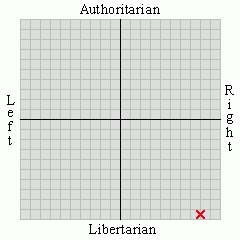Read and enjoy.
Happily, stopping distances become irrelevant because you won’t see the obstacle in the first place. By the time you know it was there, you’ll have gone through the windscreen, through the Pearly Gates and be halfway across God’s breakfast table.
Tuesday, December 30, 2008
The Incomparable Bugatti Veyron
Wednesday, December 24, 2008
Monday, December 8, 2008
Ubuntu Studio missing network manager
Monday, July 21, 2008
Cheap solid state router using Endian Firewall
/dev/hdb3 / ext3 noatime 1 1
/dev/hdb4 /varperm ext3 noatime,mand 1 1
none /var tmpfs noatime,mand 0 0
none /tmp tmpfs defaults 0 0
none /home tmpfs defaults 0 0
none /proc proc defaults 0 0
none /dev/pts devpts gid=5,mode=620 0 0
/dev/cdrom /mnt/cdrom udf,iso9660 noauto,owner,kudzu,ro 0 0
/usr/bin/rsync -a /varperm/ /var/
/usr/bin/rsync -a /homeperm/ /home/
I also added /etc/cron.d/syncflash to /etc/rc.d/rc.halt, right after the "Shutting down" line at the top of the file so that I flush to flash whenever I shut down.
#!/bin/sh
/usr/bin/rsync -a /var/ /varperm/
/usr/bin/rsync -a /home/ /homeperm/
I'd probably exclude the gzipped stuff, myself, but that depends on the amount of space you have. Since tmpfs allocates half your RAM by default, we effectively have a 750MB combined /tmp and /var filesystem. This is plenty, really. We can even enable the proxy and ntop, so long as we set the limits to something reasonable. I may hack it further to keep longer logs on flash and continually flush tmpfs, but what I have works for now. I think this may be a really good solution for a dedicated router box, maybe using something like a Fit PC. Addendum: Fit PC does not have enough memory for this application. But an old laptop and a PC Card CF reader might do the trick. I also had to change the options from defaults in the /var line to enable mandatory locks. Havp would not start without this setting, which kept squid from working correctly.
Wednesday, June 11, 2008
Worst. NIC. Ever.
Friday, February 15, 2008
Brief trashing of Dune: The Battle of Corrin
Dune: The Battle of Corrin is the third book of the Butlerian Jihad trilogy by Brian Herbert and Kevin J. Anderson. The book attempts to build upon the proud legacy of Frank Herbert's classic Dune series. Unfortunately, it suffers from some terrible, fatal flaws. The characters are totally unconvincing. They simply do not recognizably react like humans. On the one hand, military people have little compunction about exterminating entire planets, but then are afraid to attack the Omnius when the thinking machines threaten to kill hostages. It is a bizarre thing to make a major plot point. I do not know if this is a weakness inherent in the notes left behind by the original creator, or an oversight by the new writers, but it completely ruins the ending of the story.
As are all Dune stories, this story is a dystopian nightmare, but the Herbert/Anderson collaborations are even worse. Earlier in the story, things were already looking bad: Rather than simply go their separate ways and divide a tribe, two people decide to have a battle to determine who gets the right to rule. And these are people who are allegedly disgusted by slavery. But there they are, deciding who will have the right to enslave, when there was a very simple solution in front of them.
I find it bizarre that no one seemed to think that it might be worth trying, as a military strategy, to attack Omnius with the Holtzmann satellite generators. They had a blanket perimeter on the planet, through which no thinking machine could pass. Why not just advance the blanket toward the planet and eradicate thinking machines as you go? You can keep building more satellites to back up those with which you are attacking. It's just a stupid oversight. Also, they exterminated planets with nuclear weapons to destroy the Omnius Everminds on those worlds, but occasionally humans survived, but Omnius did not? Why wouldn't Omnius, a machine, embed himself very deep under the crust of the planets?
At the end, Omnius plans to beam himself as a big data packet into space? Hoping for a receiver? What possible reason would there be to think that such a transmission would bring about any useable thing on the other end.
These are only a few highlights of my problems with this book. I found it to be, quite frankly, one of the worst science fiction books I have ever bothered to finish.

